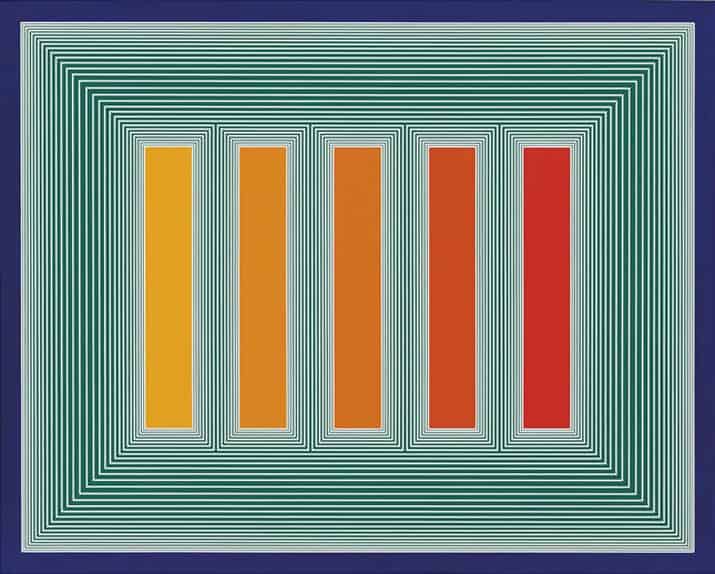
Richard Anuszkiewicz
We Buy Richard Anuszkiewicz Art
Click To Get A Valuation Of Your Richard Anuszkiewicz Painting. You’ll get a confidential fair market valuation of your painting and its marketability. We pay cash for paintings by Richard Anuszkiewicz and take consignments to the gallery.

Richard Anuszkiewicz Art (1985)
Temple of the Evening Sunset with Dark Blue
Acrylic on canvas, 48 x 60 inches
RICHARD ANUSZKIEWICZ BIOGRAPHY
Richard Anuszkiewicz (born 1930)
As a leader of the Op Art movement, Richard Anuszkiewicz art is as distinctive as it is unforgettable. He once said, “Color function becomes my subject matter and its performance my painting”. Anuszkiewicz explored new techniques and methods and helped expand the psychological theories of color and perception. Clear evidence of this are his extraordinary artwork from the 60’s and 70’s.
Born in 1930 in Erie, Pennsylvania to Polish immigrants, Richard Anuszkiewicz started young on art and stuck with it. From a small boy drawing with crayons to a scholarship to the Cleveland Institute of Art at age 18, it was clear where his passions lay. He began by depicting scenes from daily city life in his paintings. Then he began to hook onto the ideas of abstraction during his studies at Cleveland. Abstraction appealed to him, but so did the elements of design.
At the end of his time at Cleveland in 1953, Richard Anuszkiewicz won a Pulitzer scholarship to the National Academy of Design. He then studied at Yale with the pioneer Josef Albers. It was at Yale that he started studying the psychology of perception. There he laid the groundwork for his later theories of visual and spatial organization. This was a fertile time for Anuszkiewicz and his art that survives from that time give clues towards his future direction.
New York in the late 1950’s was a hotbed for art, music, literature and philosophy. The Jazz scene was pushing boundaries, the Beat poets were spitting lyrics that caused howls of outrage, and artists were flocking there as well. Among these artists was Richard Anuszkiewicz. He began working as a conservator for the Metropolitan Museum of Art. Then for the famed Tiffany and Co. as a silver designer. Then abstraction really took hold of Richard Anuszkiewicz. Using his unique sense of mathematical geometry and expanding on his theories of perception he started at Yale, he used repeated organic and geometric patterns and forms to make designs that confound the eye and cause the brain to rethink its preconceptions.
Over time, Richard Anuszkiewicz art became what we now recognize as his rigid, structural, bright, even trippy style. About 1960, Richard Anuszkiewicz Op Art gained the attention of the art world. For the next three years he continued to experiment, theorize and produce art. Then Time magazine published a flattering article on him and he gained national and international fame. Finally he was able to sell as many paintings as he could produce, selling 17 in a single month at one point. One of his more famous contemporaries, Jackson Pollock, had a smaller waiting list for his paintings, which should give a good idea of the fevered popularity of his Richard Anuszkiewicz’s art.
Anuszkiewicz held one-man art shows from 1965 onward. Many regarded him as the most important artist in the Op Art, or Optical Art, movement sweeping the art world. The hippies in America and Europe seized on the amazing color theory set down by Anuszkiewicz. His theories challenged the idea that perception is fixed or reliable. Try staring for a while at one of Richard Anuszkiewicz’s best art designs and the conclusion is that one’s eyes cannot be trusted.
This met well with the expansion of “radical” thought during the 1960’s and 70’s. Posters for festivals, sit-ins and rock concerts used the fluorescent, conflicting and contrasting colors and geometry popularized by Richard Anuszkiewicz art. Life magazine called him the “Wizard of Op”, and later retrospectives uphold the vibrant and timeless quality of his work.
Few artists have been so influential outside their field, but for many the 1960’s are synonymous with the Op Art perfected by Richard Anuszkiewicz. This was “non-representational” art which did not mean anything unless you projected your meaning onto it. While it may appear that his art is confined by geometry and is well planned, we know from his sketches and trial pieces that he was an experimenter. Richard Anuszkiewicz artwork evolved organically into their final composition.
Enjoying Richard Anuszkiewicz’s artwork requires no prior knowledge of art. It is pure in that it has an effect on the viewer, unlike most art which is often the expression of feeling or thought. His art is especially appealing to children. They tend to respond instinctively and often with joy to the profound, yet deceptively simple artwork.
We Buy Richard Anuszkiewicz Art
If you’re interested in selling your Richard Anuszkiewicz painting, please submit complete details using our Sell Your Art page. All inquiries are confidential.